March 12, 2024
I’ve had only one other Magdalen Nabb Cocktail Talk, even though I’ve now read four of her books starring Marshal Guarnaccia, a persistent marshal in the Carabinieri (the second police force in Italy, one that grew out of the military and has a sometimes helpful, sometimes less relationship with the Polizia di Stato). The books take place in Florence, a city I’ve visited and loved lots, so I should really have a few more of Cocktail Talks from said books – here’s hoping the future leads to that very occurrence, especially as I find myself very fond of the Marshal, whose steady, non-flashy, neighborhood cop-y sense and regular Italian sensibility are very enticing in a way. Not to mention that he interacts with barmen serving Campari, which I always like to read about.
“Let’s hope not. I don’t want any shoot-outs with terrorists taking place in my bar, thanks.”
And he, too, began to scan the innocent-looking tourists.
“Rubbish! That sort of thing only happens in Rome . . .”
But both them touched the metal edge of the counter to ward off evil, and the barman, dropping ice-cubes into three Camparis for an outside table, kept an eye on the Marshal’s broad back.
–Magdalen Nabb, Death of a Dutchman
Tags: Bars, Campari, Cocktail Talk, Death of a Dutchman, Florence, Italy, Magdalen Nabb, Marshal Guarnaccia
Posted in: Bars, Campari, Cocktail Talk, Italy
August 27, 2021
It’s funny (to me, if no-one else) to have a very tough drink name like “Fugger’s Revenge” for a light-bodied, friendly, vermouthy (in a way, though I’m not calling this vermouth, cause I don’t want the vermouth board after me), aperitif-style sipper (the aperitif board is much less ferocious). But the backstory really is not so tough, but is one of my fav wine stories (one that some people say isn’t true, is just apocryphal, etc. Some people are also fuddy-duddies and no fun to have a drink with. Avoid them). Anyway, it starts early in the year 1111. A forward-thinking German bishop named Johann Fugger was getting ready to travel to Rome for the Holy Roman Emperor’s coronation (this one was Henry V). Because he was forward-thinking, Fugger sent his assistant along the road first, to scope out the local wine, chalking the pubs or bars or 12th-century what-have-yous that had good wine with the word “est,” which is Latin for “there is” (the full phrase he kept in his wine journal was I believe “vinum est bonum” or “wine is good” basically). When this intrepid wine scout came into the town of Montefiascone, he so enjoyed the wines that he A: had a lot, and B: wrote Est! Est!! Est!!! on the bar’s outside wall to show his enthusiasm. I believe bishop Fugger himself liked these particular wines so well he never made it to the coronation, just stayed in Montefiascone drinking wine, and is buried there today. And, the white wines designated Est! Est!! Est!!! di Montefiascone are still made and enjoyed. And (here’s where it also comes back around), this particular homemade aperitif uses an Est! Est!! Est!!! di Montefiascone wine as it’s base! Neat! Awesome! Story!
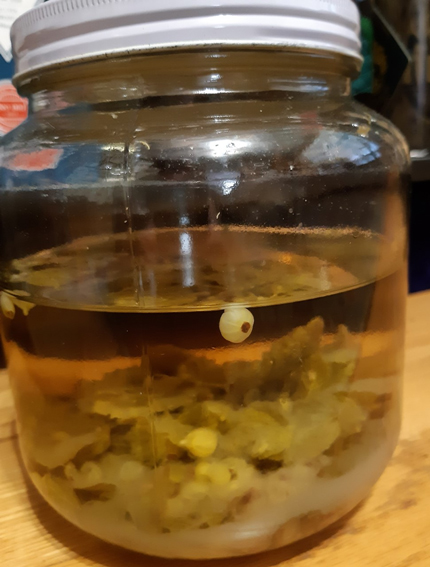
There aren’t a wide range of these whites available here, but Pietro Est! Est!! Est!!! tends to be available, and it’s what I used. Light, apple-y, dry, and very refreshing, it provided the perfect platform for building this summertime aperitif (and it won’t set you back too much). The other flavorings almost all came from my yard, including white currants (want to know way more about my white currant bush? Check out the Currant Current liqueur, Strawcurranterry, a white currant strawberry liqueur, and A Particular Friend, a white currant mint number), fresh mint, and fresh marjoram. A little gentian root because life is bitter (but not, one hopes too bitter most days), a little vodka to im-proof things a bit (but not too much, as this is a very light-on-its-feet charmer), and a little simple syrup to round our edges without making it sweet. Altogether, this late summer aperitif rises to the level of the wine story with delicate herbal and fruit notes. Pretty swell on its own, chilled or over ice, but also a pleasant pal in cocktails (heck, though it is not a vermouth, it would make a mean Martini-esque drink when paired with a London-style gin).
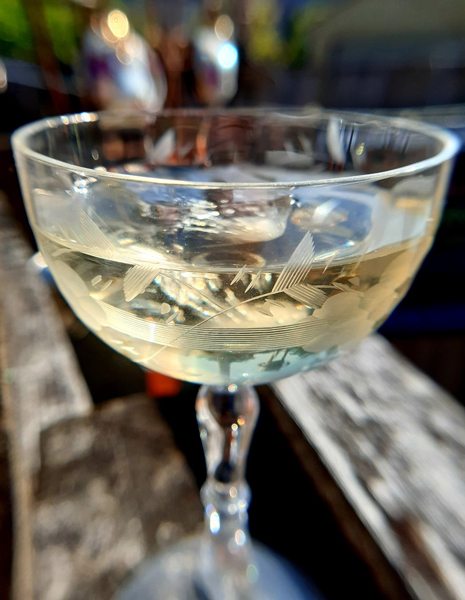
Fugger’s Revenge
1/2 cup white currants
1/3 cup fresh mint
1/4 teaspoon gentian root
1 Tablespoon marjoram
1 750 ml bottle Pietro Est! Est!! Est!! white wine
1 cup vodka
1/2 cup simple syrup
1. Add the currants, mint, gentian, and marjoram to a large glass jar with a good lid. Muddle well, but not wackily (you do want to break up the currants as much as possible).
2. Add the wine and vodka, and stir. Put in a cool dry place and let sit for two weeks, swirling regularly.
3. Open up the jar of joy and add the simple syrup. Stir again, and re-place in that cool dry place. Let sit two more weeks, swirling as you will.
4. Strain – I like to strain once through a fine mesh strainer, then twice (or as needed) through cheesecloth – into a good glass bottle. Store in the fridge (to keep nice and chilled).
Tags: aperitif, Chase Smoke flavored vodka, cocktail, Cocktail Recipes, Est! Est!! Est!!, Friday Night Cocktail, Fugger’s Revenge, gentian, homemade aperitif, Italy, marjoram, Mint, Pietro Est! Est!! Est!! white wine, What I’m Drinking, white currants, white wine aperitif, Wine
Posted in: aperitif, Cocktail Recipes, Italy, Recipes, vodka, What I'm Drinking, Wine
May 28, 2021
You know those Fridays when you aren’t sure what to make, cocktail-wise, and you go to the shelves, and pick up the biggest library of cocktails you can get, or, to be specific (both language-wise and title-wise), Il Grande Libro dei Cocktails? Those ones? No? Yes? Well, either answer, this happened to me recently – luckily, I’d picked up said grand library, oh, now a few years back in a swell used bookstore in Sansepolcro (I sure hope that bookstore is still there and open through it all), so on this Friday I could open it, swing over to the “Cocktails del Amore” chapter (cause I’m a romantic, and cause I really like this picture of these cuddly glasses kissing – aren’t they cute!
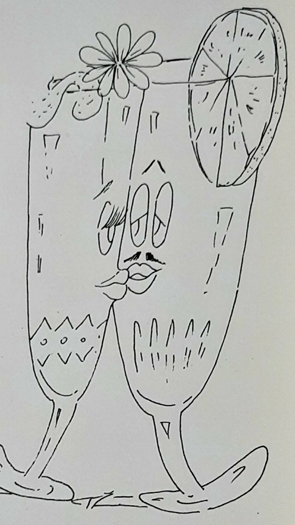
), and decide to make a drink I’ve never made, called Baciami Subito, which was so intriguing, and which really shouldn’t have, to me at first glance at least, made sense: I mean, dark, rich, intriguing Cognac with light, springy, dry vermouth, and then bitter Angostura with it, too? On the flip side, it does sound good, now that I type it out, and, you know what, it is! Those lighter notes from the vermouth really start to accent the Cognac once mixed. But is it right for the romance chapter, which here (and otherwheres) tends to lean to sweeter liquid fare? However! If you realize or remember that Baciami Subito means “kiss me right now,” well, then, it’s a twist (no twist here though, but a cherry), because this drink does have a tasty kick that not only could induce rapid kissing, but also can me you feel fun-oozy like a good quick kiss. So, there we are, smooches all around!
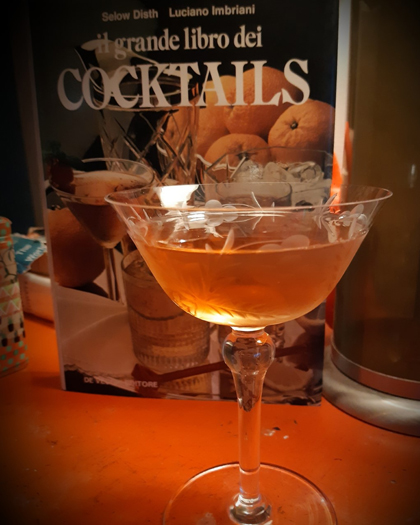
Baciami Subito
Cracked ice
2-1/4 ounces Cognac
1-1/2 ounces dry vermouth
2 dashes Scrappy’s Aromatic bitters (the book suggests Angostura, which is dandy I’m sure, but I had the also-dandy Scrappy’s Aromatic neat. The book also suggests three dashes, but I found two enough)
Cherry, for garnish
1. Fill a mixing glass or cocktail shaker halfway full with cracked ice. Add the Cognac, vermouth, and bitters. Stir well, or “vigorosamente!”
2. Add a cherry (or two if feeling flirty) to a cocktail glass. Strain the mix from Step 1 into the glass and over the cherry. Sip, and kiss at will.
Tags: Baciami Subito, bitters, cherry, cocktail, Cocktail Recipes, Cognac, dry vermouth, Friday Night Cocktail, Il Grande Libro dei Cocktails, Italy, Scrappy's, Scrappy’s Aromatic bitters, What I’m Drinking
Posted in: bitters, Cocktail Recipes, Cognac, Recipes, vermouth, What I'm Drinking
July 14, 2017
There are times, when the Mercury’s rising and that big ol’ ball of heat in the sky is high overhead, when you want a classy drink, but one that isn’t too tough. A drink that has all kinds of flavor, but without involving any sweat (or little sweat) to make. A drink you could sip after a long day of work while the sun starts its long slow trip down westward, as well as during a family brunch on Sunday when you’re waking up slowly.
Well, this is that drink friend! It covers all those bases, though admittedly it might be best during the Italian aperitif hours, those beautiful moments before dinner (let’s say 5 to 7, though they can arrive a stitch earlier or later) when you want to have something a little effervescent and light, but still with character and taste. All those characteristics come together here with just two ingredients – and a lemon twist – starting with Mionetto Prosecco, specifically the DOC Treviso brut version (though all the Mionetto Proseccos, made since 1887, are worth tracking down). The Treviso brut is nice and dry and crisp, with apple and peach and flowers lingering on the tongue, along with a hint of honey.
Here, it’s mixed with another Italian number, the newest sibling of renowned Galliano (the L’Autentico golden liqueur in the memorable bottle), Galliano L’Aperitivo, just recently becoming available stateside. An amaro, or bitter, it boasts over 50 ingredients, including a bouquet of citrus – orange, bergamot, tangerine, grapefruit, others – and a mix of herbs and spices like cardamom. The flavor’s rich, with all those orange-y citrus notes, herbaliciousness, and a hint of bitter.
Together, these two Italian stalwarts come together beautifully – with lots of fruit flavor, but with a dryness that is swell in summer, when you want to keep the cloying nature of some drinks far away. The color is also rather amazing, adding another welcome touch.
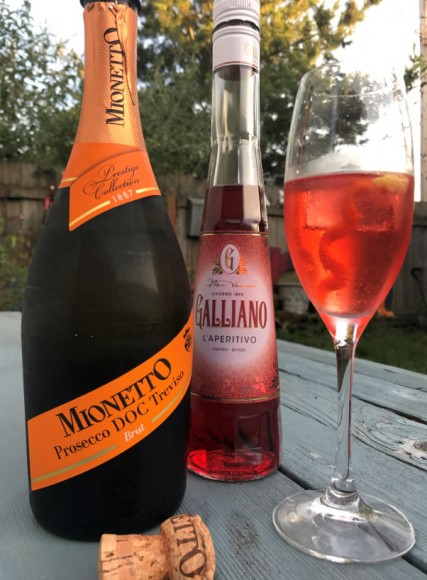
The Summertivo
3/4 ounce Galliano L’Aperitivo
4 ounces chilled Mionetto Prosecco DOC Treviso brut
Lemon twist, for garnish
Ice cube, if wanted
1. Add the L’Aperitivo to a flute or comparable glass. Top with the prosecco.
2. Carefully stir in a manner that brings everything together without being wacky. If your prosecco isn’t really chilled, or if it’s extra hot out, add an ice cube.
3. Garnish with the twist. Give a toast to the sun, and to Italy.
Tags: amaro, aperitif, cocktail, cocktails, Friday Night Cocktail, Galliano L’Aperitivo, Italian drinks, Italy, lemon twist, Mionetto Prosecco DOC Treviso brut, Prosecco, summer drinks, The Summertivo, What I’m Drinking
Posted in: aperitif, Champagne & Sparkling Wine, Cocktail Recipes, Italy, Liqueurs, Recipes, What I'm Drinking
March 22, 2013
So, I’m in Italy. And since it’s springtime, and sunny, I’m sitting outside of Bar Pina (which is outside of Umbertide), one of the finest spots anywhere to sit in the sun and have a beer. I mean, it’s in Italy. Which means that this Friday Night Cocktail isn’t as fancy as others, but I wouldn’t trade it for any of them. And if you want to feel jealous about it all, well, that’s up to you. But a better impulse might be for you to just come on over to Pina your-own-self. It’s pretty darn fun.
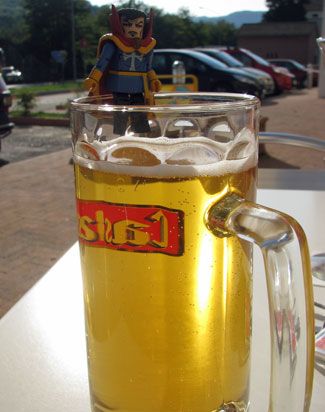
PS: Yeah, Dr. Strange drinks with me when I’m at Pina. And you thought it couldn’t get any better.
October 19, 2012
This is quite a continental moment here on the Spiked Punch. First, tonight, like I usually do on the continent, I ate too much. Then, to combat my over-indulging, I had a healthy dose of Elisir di Salvia, a digestif I made from a recipe taken out of a simply-named book, Tisane, Liquori and Grappe. I have no idea who it’s by, but it’s from the Demera Company and is Italian (which means I translated the recipe. Yeah, I do everything for you. But you deserve it). I picked it up in a little tucked away bookstore in Sansepolcro’s historic center, called Arca Dei Libri. Nice place, really. Only blocks from the can’t-miss-it restaurant Fiorintino. Anywho, Elisir di Salvia is a curious mix of stuff, and the taste reflects it: herb and spice sweetness at the beginning, mellowing Marsala middle, totally different backend flavor and kick. At first, I wasn’t sold, but now I think it’s a weird kind of genius drink. And yes, I felt better after having it after eating too much. Oh, when in the jar cooling its heels, it looks like this:
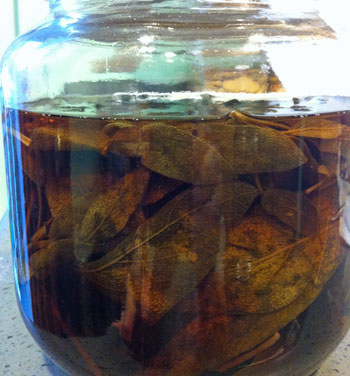
Elisir di Salvia
1 liter Marsala
1 cup fresh sage leaves
1 orange rind
2 cups high proof vodka or grain alcohol
1/2 cup warm water
1.6 cups sugar
1. Add the Marsala, sage, and orange to an airtight glass container airtight. Let sit for 10 days to two weeks. Shake at least once a day.
2. Dissolve the sugar in the water to make a syrup, let cool, and then add it and the vodka.
3. After 24 hours of rest (or a week, if you’re lazy like me), filter and transfer to a glass bottle. Take 1 shot from the liqueur in all cases of difficult digestion.
Tags: cocktail recipe, Cocktail Recipes, digestif, Elisir di Salvia, Friday Night Cocktail, homemade liqueurs, Italian digestif recipe, Italy, What I'm Drinking
Posted in: digestif, Italy, Liqueurs, Recipes, What I'm Drinking
March 30, 2012
Sometimes, I’m almost too sad to write more than one sentence. Or six. This is one of those times, because we recently finished our last bottle of Bindolo, the wine from Donini we drank a fair amount of when we lived in Italy. You can read more about Bindolo and Donini in this past post, and then get on a plane and go pick some up (and tell Diego hello for us). Me, I’m going to look at the picture and tear up (though the sadness is partially offset by the fact that we shared that last bottle with pals Rebecca, who makes the great Deluxe jams and cocktail syrups, and Eric, who owns the best bike shop in Seattle, JRA. At least we had that last bottle with awesome folks).
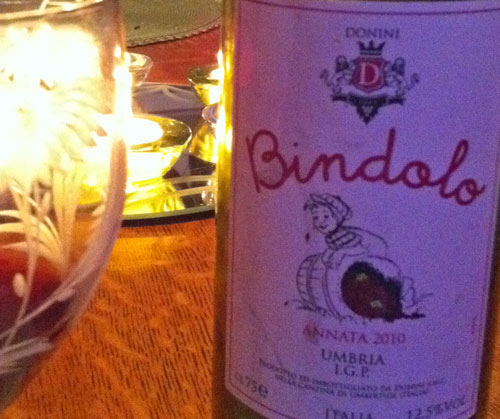
May 23, 2011
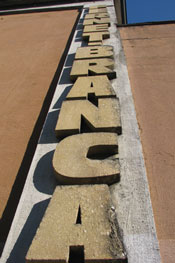 If you haven’t read Part 1 of our Branca Distiller tour, well, do so now. It talks lots about company history, the Collezione Branca, the Branca philosophy of novare serbando (renew but conserve), and much more. Go read it. Okay, are you back? Now we’re ready for Part 2, in which we actually get to walk around the distillery and see where the magic happens. Still with our tour guides Elisa, Marco, and Valeria, we last stopped at the Carpano area of the museum, where we learned more about Branca’s purchase of Carpano Antica (and the full Carpano family of vermouths), had a quick drink of Carpano Antica, and then got ready to hit the distillery proper. But first, as we’re walking into delicate areas, we had to suit up (attractive, aren’t we?):
If you haven’t read Part 1 of our Branca Distiller tour, well, do so now. It talks lots about company history, the Collezione Branca, the Branca philosophy of novare serbando (renew but conserve), and much more. Go read it. Okay, are you back? Now we’re ready for Part 2, in which we actually get to walk around the distillery and see where the magic happens. Still with our tour guides Elisa, Marco, and Valeria, we last stopped at the Carpano area of the museum, where we learned more about Branca’s purchase of Carpano Antica (and the full Carpano family of vermouths), had a quick drink of Carpano Antica, and then got ready to hit the distillery proper. But first, as we’re walking into delicate areas, we had to suit up (attractive, aren’t we?):
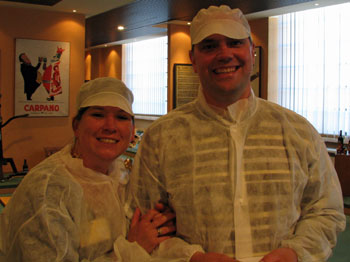
Check out the wonderful Carpano ad in the background, too. Yet another piece of Branca-related advertising I wish I had framed in my house. After suiting up, we started by going through a few doors into the Borghetti coffee liqueur room. Now, here’s where I have to admit one downside for you, dear readers, in this Part 2 of the tour post. We couldn’t, in most areas of the distillery, take pictures. As mentioned in Part 1, having delicious liqueurs, vermouths, and amaros means that folks are always wanting to know how you make them. Which means even someone as un-spy-ish as me (though I could be a spy, I suppose–I have that look, right?) can’t snap snaps. Borghetti, if you don’t know (and you might not, as it’s sadly not readily available in the States) is the coffee liqueur made by the Branca company. It’s a staple in Italy (all the everyday bars/cafes we’d visit had it, usually in both big bottles and in these small, 3-inch-ish, portable bottles), and I’m not 100% sure why we don’t have it in the U.S., as it’s scrumptious. Normally, I’m not either a big coffee liqueur fan or a big coffee drinker (a lot of coffee liqueurs taste ickily chemical to me), but I really love the Borghetti, and after seeing where it’s made, I know why. It only contains coffee (freshly roaster and made there), liquor, and a natural sweetener. Walking into the room where it’s made is somewhat like walking into the best coffee roaster inside Willy Wonka’s chocolate factory, as there’s a perfect sweet/coffee aroma—which matches Broghetti’s taste. Here’s what the bottle looks like, if you want to scoop some up on your travels:
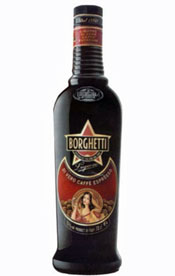
From there, we saw where the ingredients in Fernet Branca are treated during production (where the secret processes mentioned in Part 1 happen), including the big iron pot (pictured in Part 1) where the spices and more are stirred up. Amazing stuff, really, as it’s partially mechanized, but still there are always workers in attendance, watching over the process. We next went to perhaps my favorite part of the whole tour (well, just hanging out with our awesome tour guides was my favorite part, but this coming up was a close second), the cask where Stravecchio Branca spends time before bottling. Stravecchio Branca is the brandy made by the Branca company, and is another item I wouldn’t mind seeing more of over here (again, it’s in most bars/cafes in Italy and is a really good, full-bodied brandy). Here’s the bottle if you ever want to try some and you see it:
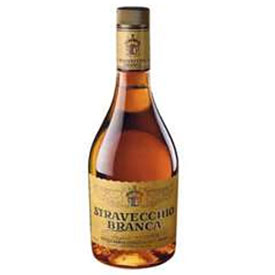
But the cask (or flask, as they referred to it as) in question we could take pics of, but we didn’t have a wide enough angle lens to do it justice. See, it’s the biggest cask in Europe, and was built over a two month time period way back in 1892. And it’s massive and astounding to stand in front of:
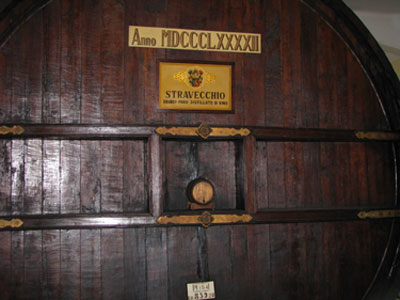
Stravecchio was originally called “Vieux Cognac,” but they had to change the name due to the Cognac rules (about it having to be made in the Cognac region of France, that is). Today, the brandy spends some time in other casks, but each batch spends a least some time in this massive cask–which is never empty, as some is always left in to ensure that the brandy stays consistent (a nice little touch). On the back of the ginormous cask, there’s a chart that tells how full it is (somewhat like the little marks made on the wall as kids get taller), alongside a little chalkboard notepad (which is alongside my head):

My favorite part of the photo (and another reason why I loved this cask so much) is right above the “B100” where the cask looks like it’s sweating. This is a slight oozing out that happens, about which Marco said, “it is crying.” He even wiped some off on a fingertip to taste, and encouraged us to do the same–which I, naturally did. It was super-brandy-charged, and I dug it so much I went back for more (hey, I have a hard time seeing anything cry). After the Stravecchio, we wandered down into the cellars, where we viewed wooden cask after wooden cask, rows of them (all lovely, by the way), first more brandy (they start here in smaller casks before moving to the biggest cask in Europe), then the wooden casks Fernet Branca is aged within. Fernet Branca has to be aged at least a year, and the brandy for three, so you can imagine that there are tons of casks (not to mention that Branca Menta is also made with aged Fernet Branca, on to which is added pure peppermint oil, sweetening, and love). All these hundreds of casks, the giant cask, the production facilities upstairs, the museum from Part 1, and the offices live in this one building, in the center of Milan, a bustling city. There’s something almost otherworldly about it, especially when wandering through the building’s many rooms and passages. One could easily get lost down here—you’d never go thirsty, luckily. Also luckily, we didn’t have to worry about getting lost, because we were with our friendly and knowledgeable (and fun) tour guides. Check them out, aren’t they great:
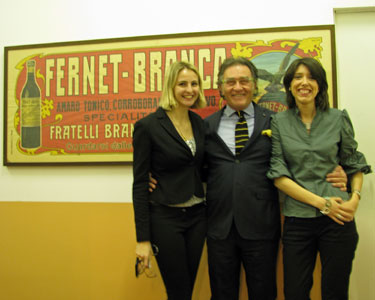
After seeing the casks, and saying our goodbyes, we walked out in Milan craving a little Fernet Branca or Branca Menta. Of course, we had a four-and-a-half hour drive ahead of us, so the cravings just became sharper, until we were back in our home Italian neighborhood, where we could indulge our Branca thirst at Bar Fizz. Thanks again Fratelli Branca Distillerie, we had a great time.
Tags: amaro, Borghetti, Branca Menta, Carpano Antica, Fernet Branca, Fratelli Branca Distillerie, Italian Liqueurs, Italy, Milan, Punt e' Mes, Stravecchio brandy
Posted in: Brandy, digestif, Fernet Branca, Italy, Liqueurs





































